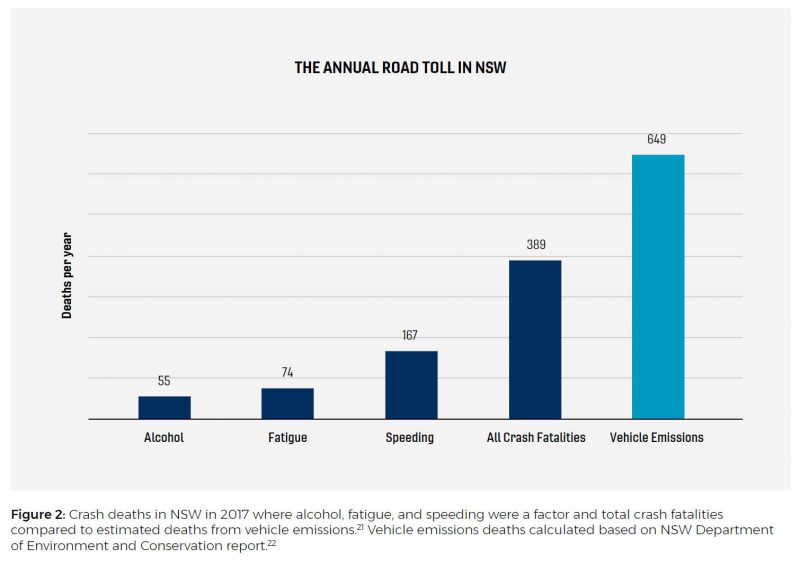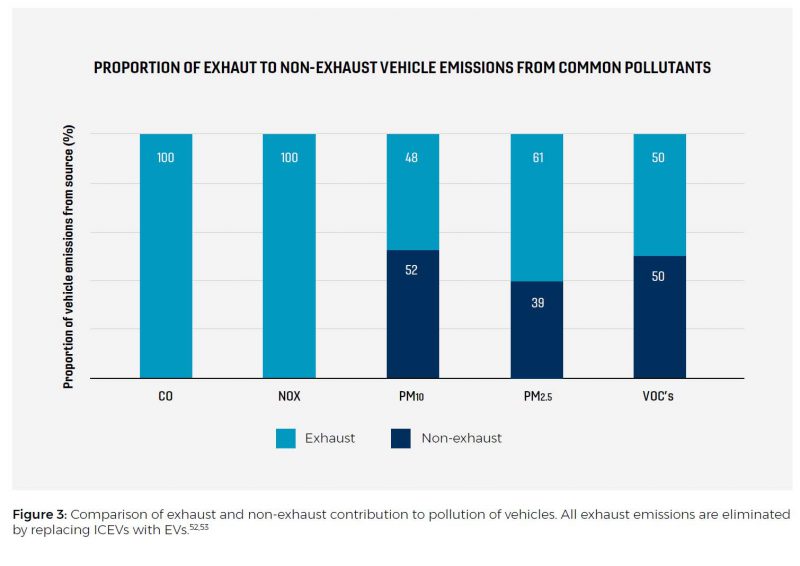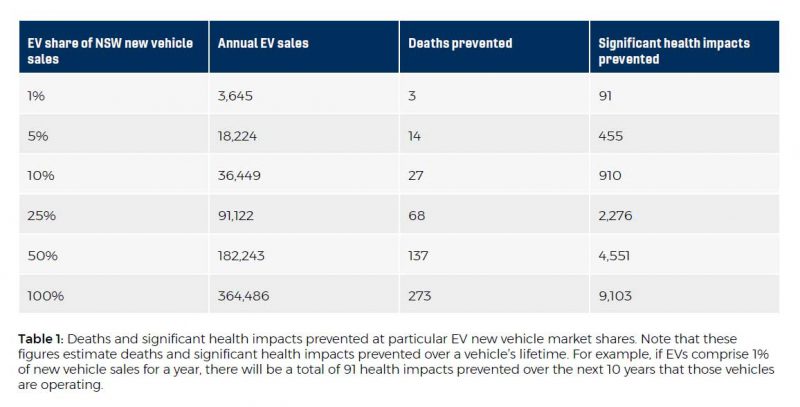"At least Sydney isn't going the same way as Perth"
Electric cars can save thousands in health costs, EVC report says
Billions of dollars in health costs could be saved if drivers in the wider Sydney region switched to electric cars, a new report issued by the Electric Vehicle Council (EVC) has shown.
Health costs of transport-related illness account for as much as $3 billion in the Sydney-Newcastle-Wollongong area alone each year, according to the “Cleaner and Safer Roads for NSW” report, adding up to a $3,200 saving per vehicle if the switch was made to electric.
The report, which has been co-authored by the EVC and Asthma Australia with assistance from Doctors for the Environment Australia, also recommends that with transport-related illnesses such as lung and respiratory disease resulting in 60 per cent more deaths than road accidents, these should be added to the NSW road toll.
Approximately 650 people die in NSW each year from transport emissions-related illness, according to data from the Department of Environment and Conservation, and if these numbers were included in road toll numbers, funding to reduce those deaths could be better directed, says Electric Vehicle Council CEO Behyad Jafari.

Source: EVC
“We’ve seen a lot of graphic road safety campaigns, but the deadliest part of a vehicle is actually its exhaust pipe,” said Jafari in a note by email.
“There are many good reasons for New South Wales to get behind a rapid transition to electric vehicles, but the most underrated is our health and safety.
“These are not abstractions. They are very real costs that are felt in very real ways. We can pump better health and more money back into the state by phasing out exhaust pipes and phasing in zero-emission vehicles.”
The emissions from ICE vehicles causing disease and death include carbon monoxide (CO), nitrogen oxide (NOX) as well as particulate pollution and volatile organic compounds (VOCs).
Electric vehicle adoption could entirely remove CO and NOX coming from vehicles, while VOCs and PM10 particulate matter could be halved.
The report states that the most harmful emissions, PM2.5 particulate matter, could be reduced by almost two-thirds.

Source: EVC
The call echoes previous statements from Doctors for the Environment as previously reported by The Driven following the release of another damning report issued by the World Health Organisation last year showing that 1 in 10 children died from emissions-related illness.
Children are particularly at risk, says Asthma Australia CEO Michele Goldman.
“Vehicle pollution is particularly significant when it comes to children’s asthma. Kids living within 75 metres of a major road have a 29 per cent increased risk of lifetime asthma,” Goldman said in a note by email.
“We often see schools built on main roads to increase accessibility, increasing exposure to asthma risk factors.
“People with asthma suffer from air pollution more than others because their airways are particularly sensitive. Indeed, anyone with pre-existing medical conditions such as asthma, lung disease, or cardiovascular disease is more susceptible. Such people have more frequent and more serious symptoms when exposed to air pollution.”
In addition to recommendations to include emissions-related deaths in the road toll, the report also shows that if all cars on NSW roads were electric, as many as 273 deaths could be prevented each year.

Source: EVC
In addition to the significant health costs associated with transport-related disease and illness, the report also noted the social cost of noise pollution from internal combustion engine vehicles.
While the silent operation of electric vehicles presents its own risks (see our report on new EU legislation regarding this), it is estimated that in NSW, the social cost of noise pollution accounts from some $1.4 billion.
Electric cars break their silence under new European law
As of July 1, all electric cars in Europe must be fitted with sound-emitting technology to reduce the risk of danger to pedestrians accustomed to noisy internal combustion engines.
While the extremely quiet operation of electric vehicles is often touted as another bonus for the emerging zero emissions form of transport, this silence is believed to present a risk to other road users, particularly the vision-impaired and their companion animals.
To mitigate this problem, the EU is introducing legislation from Monday that requires all four-wheeled vehicles to be fitted with acoustic vehicle alert systems (AVAS).
As noted on Euroblind, a UK study released in 2013 showed that despite a reduction in incidents involving internal combustion engine (ICE) vehicles resulting in pedestrian injury, there was an increase in the number of incidents involving electric vehicles:
The number of accidents where pedestrians are injured by EVs/EHVs has increased, from 98 in 2012 to 151 in 2013, an increase of 54%.
Whereas 2013 represented a record low for such accidents involving internal combustion vehicles, it was a new high for electric/hybrid-electric vehicles, with the percentage increase in accidents far outstripping the increase in vehicle numbers.
With electric vehicle uptake in Europe and the UK now well and truly on a steady incline, a decade of campaigning has resulted in the new EU legislation.
The regulation, listed as ‘Regulation on the Sound Level of Motor Vehicle’ on the EU’s legislation website, states that for all electric vehicles the AVAS must be operating at a minimum of 56 decibels when the vehicle is driving at speeds up to 20km/hr, and no louder than 75 decibels.
That’s about the same level as an electric toothbush or paper shredder, says acoustic device maker Harman, which has been developing AVAS devices for the past decade.
“Given the ever-increasing number of hybrid and electric vehicles on our roads, the risk to pedestrians, cyclists and vulnerable groups has risen exponentially over the years,” said Rajus Augustine, senior director for car audio product strategy at Harman in a note by email.
“AVAS technologies … offer an affordable and effective way of increasing pedestrian awareness of an approaching EV in noisy urban environments.”
Designed particularly for certain situations – including when a vehicle is backing out of a carpark, or pulling into a driveway at slow speeds – the new rule also states that the AVAS sound ‘should be a continuous one providing the vehicle driving behaviour to other road users and pedestrians.’
For example, there must be changes in the sound level and pitch to indicate the vehicle’s acceleration.
Carmakers are coming up with some interesting approaches to the new rule.
https://thedriven.io/category/ev-news/







